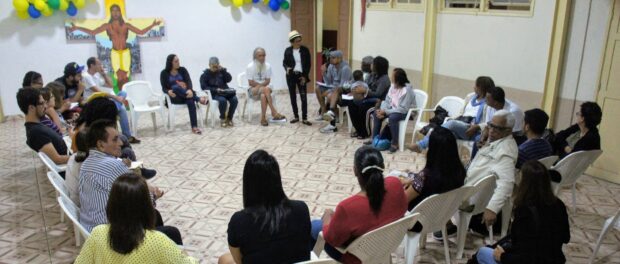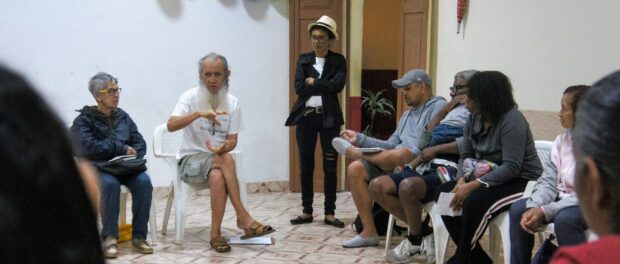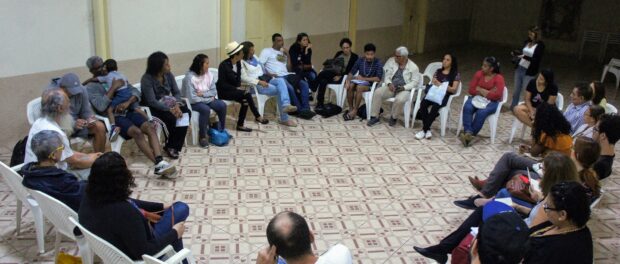
The Rio de Janeiro State government recently announced a new massive upgrading project for Rocinha, Rio’s largest single favela, located in the South Zone. The program, called Comunidade Cidade (Community City) was debated on September 14 by Rocinha Sem Fronteiras (Rocinha Without Borders), a community group dedicated to ensuring monthly resident debates on the timely issues affecting them. The meeting was held at the Parish of Nossa Senhora da Boa Viagem, with a focus on Community City’s sanitation elements.
Rocinha Sem Fronteiras‘ monthly meetings always emphasize the direct participation of residents while also welcoming an outside expert on the topic of the month. However, this month, guest speaker Ruth Jurberg from the State Secretariat of Infrastructure and Public Works did not attend, claiming she had been advised to only discuss the matter once it had been made official.
The meeting went ahead despite the unusual circumstances, with the members themselves leading the meeting and approximately 30 people in attendance. José Martins, 72 years old and coordinator of Rocinha Sem Fronteiras said, on the subject of the Comunidade Cidade project, that he had a concern: the lives of the thousands of families involved.
“I think the state is only considering top-down solutions and not taking other factors into consideration. The right thing to do would be to open up the process to allow residents, who are the main stakeholders, to effectively participate. Also, I’m very concerned about the 7,000 families who are expected to be removed. We need clarification and transparency on how this process will be carried out and where these people will go,” he said.
In recent years, the favela of Rocinha has been the target of dozens of projects, including the second phase of the Growth Acceleration Program (PAC), which was first slated to include the construction of a cable car route, but was opposed by residents, and the reopening of the Park Library (C4). The library, in turn, was ultimately reopened by the state government and not by City Hall, with the latter also promising a “makeover” that never materialized.
This time, around R$1.5 billion (US$360 million) was announced in investments for community re-urbanization. But questions such as “what [elements] will be respected from the urbanistic studies that have already been completed in consultation with the population?”; “how will residents be compensated?”; and “where is the plan that will be implemented?” were raised during the meeting. Professor Roberto Lucena, 53, was one of many residents to point out a lack of concreteness of this current plan.
“I think that the Cidade Comunidade project is still a little nebulous, as it doesn’t spell out how many will actually be affected: 7,000 people or 7,000 families? Will residents be relocated inside or outside of the favela? For the project to work, it has to have popular participation, in other words, residents need to be involved. Above all, to establish basic sanitation. If not, it will be another electioneering exercise and the population will once again be left waiting, hoping for something to be done,” commented Lucena.
Photographer Cristina Pedroza, 46, is not a resident of Rocinha, but often attends meetings run by the groups Rocinha Resists and Rocinha Sem Fronteiras. For Pedroza, “Rocinha’s chronic infrastructure problems of housing, sewage, etc., are longstanding. Therefore, solutions are urgent. These are not matters of government favors or benevolence; infrastructure is a right guaranteed by the constitution. Furthermore, it is the right of residents, and any citizen, to have access to the transparency of these actions and to participate in decisions that will impact their lives. I have been visiting Rocinha for a number of years, so I heard about this project announced by the state government for Rocinha, called Comunidade Cidade, through local residents. People are expressing distress and outrage due to the lack of accurate information about these urban changes. It is not enough to undertake upgrading works, it needs to be carried out through creating channels for listening and dialogue with the local population.”
Residents have been left with many doubts around the project, and explained that information related to the project has been obtained through the press, not from the government. However, it was clear at the meeting that, even with all the discussion and doubts raised about the Comunidade Cidade project, the residents present wanted to see something actually done, but in a way that is safe, participatory, and truly beneficial for the entire population.
Photos by André Sales Batista.


